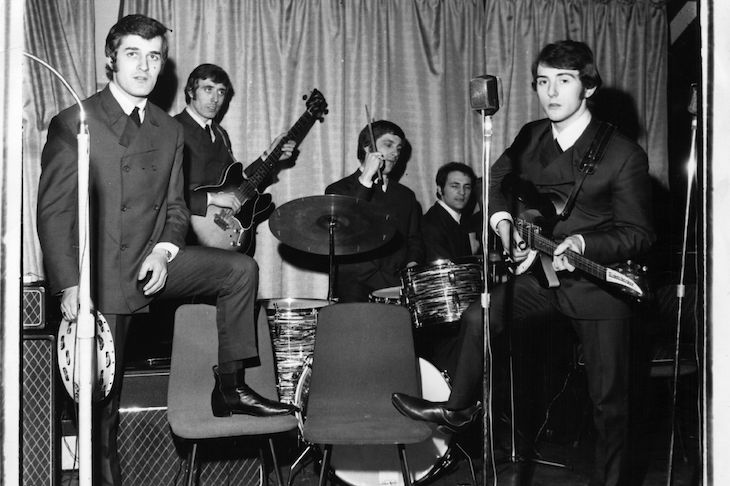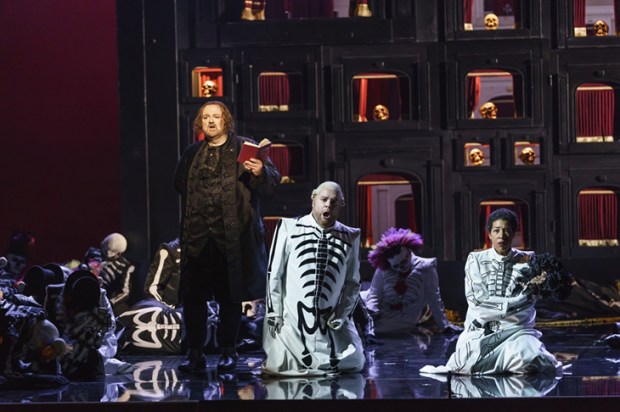Rarely has one irate punter so affected a band’s trajectory. Without the anger of the man who went to see the Moody Blues at the Fiesta Club in Stockton in 1966, the band would never have reinvented themselves, never have transformed into psychedelic pioneers, and next month they would not be travelling to America to be inducted into the Rock and Roll Hall of Fame, the honour bestowed annually upon those the US music business deems the most significant artists of all.
The Moody Blues had been a moderately successful group — everyone who has ever listened to an oldies radio station knows their version of ‘Go Now’, a No. 1 single in 1964 — but by 1966 they were on the skids. Their two most creative members had left, to be replaced by a new bassist and the 19-year-old singer-guitarist Justin Hayward. That night in Stockton, in a club where a version of the Playboy bunnies was a major attraction, the group donned their blue suits and went through their tired routine of R&B covers and comedy songs, earning the money for the repayments on their guitars and the cost of their petrol.
‘We really weren’t very good,’ Hayward recalls. ‘This chap came in the dressing room afterwards, and he said, “I just thought I’d tell you, you’re the worst fucking band I’ve seen in my life. You’re rubbish. And somebody’s got to tell you.”’ Hayward burst into tears, joined by his bandmate Ray Thomas. An hour or two later, as the group passed Scotch Corner on their drive south down the A1, the drummer Graeme Edge piped up from the back of the van: ‘He’s right, that bloke. We’re crap.’
‘Literally the next day, we said: let’s get rid of the blue suits and do our own songs and see what happens,’ Hayward says.
What the Moody Blues did next was one of the most dramatic about-turns in pop history: their 1967 album Days of Future Passed (marked with the release of a live re-recording this month, recorded last year). Days of Future Passed is an extraordinary record — a song cycle tracing the course of a day, with spoken word passages, orchestral interludes, and the song that came to define the group, ‘Nights in White Satin’. It’s extraordinary in good and bad ways: it’s florid and overblown, as well as wildly ambitious and often very beautiful. It’s peak English psychedelia, and it made them superstars.
Yet while pretty much every other English group who reinvented themselves as psychedelic vagabonds have found themselves, at some point in recent years, hailed as pioneers and trailblazers, the Moody Blues have remained stubbornly critically unrehabilitated. Even Hayward jokes that the real reason they’re being inducted into the Hall of Fame is that ‘they ran out of hip people to give it to’. It sometimes feels as though critical perceptions are unchanged since an interviewer from Zigzag magazine met Hayward in 1976 and — in a sympathetic piece — said of the band: ‘They’re very respectable, most of them are stinking rich, and they make records which sell to middle-class trendy young couples living in the stockbroker belt who know and care as much as about rock music as Batman.’ That despite the fact that Hayward was very much part of Swinging London, smoking dope — ‘turning on’, as he still calls it — dropping acid, and going to the right parties and the right clubs.
Days of Future Passed wasn’t meant to happen. The Moody Blues’ label, Decca, had sent them to the studio to record rocked-up versions of Dvorak to demonstrate their new ‘Deramic Sound’ stereo recording system. The band instead hijacked the sessions to their own ends.
‘It was all done in a week,’ Hayward says. ‘Our stuff was recorded in two or three days, and then the orchestra was done on a Saturday in one three-hour session. They had one run-through, had a tea break, and then they did their take.’ The album was mixed on the Sunday, then on the following morning the executive producer Hugh Mendl had to present it to the patrician Decca board. ‘And of course they were saying, “This is not Dvorak! This is not what we wanted!” And Hugh was saying, “No, but it’s quite good, and I think it will do the trick for us.” So they put it out as a budget-priced album, but then people started to become interested in it.’
Fifty-one years later, the Moody Blues still have a career thanks to the decision to drop the blue suits and embrace the cosmic. But Hayward understands why they remain oddly peripheral even as pop’s heritage is pored over and picked through. ‘We made some great records and we made some lousy records,’ he says. ‘Every one of the reviews, I could see exactly what they meant. Would I have bought the Moody Blues? That’s the question I have to ask myself. That’s the dilemma for me. I do sometimes think: why do people like this? I can’t quite figure it out.’
Got something to add? Join the discussion and comment below.
Get 10 issues for just $10
Subscribe to The Spectator Australia today for the next 10 magazine issues, plus full online access, for just $10.
You might disagree with half of it, but you’ll enjoy reading all of it. Try your first month for free, then just $2 a week for the remainder of your first year.














Comments
Don't miss out
Join the conversation with other Spectator Australia readers. Subscribe to leave a comment.
SUBSCRIBEAlready a subscriber? Log in